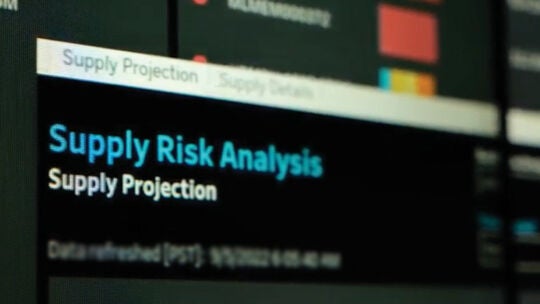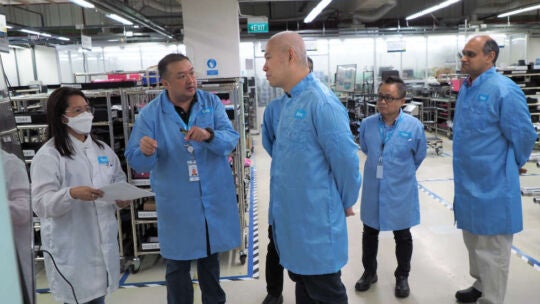
If you’ve spoken to a supply chain professional in the past year, the word “resiliency” has likely come up more than once. Today, companies are looking for new ways to build, refine, or maintain resilient supply chains. Though resiliency should be built into a company’s goals, it cannot be treated as the final destination or something companies can put a pin in and say, “we’ve achieved it!”
Resiliency recognizes that disruption is inevitable and constantly evolving. Therefore, a resilient supply chain is one that can quickly recover from ongoing disruptions, no matter how large or small. The key word here is quickly — how fast you overcome such disruption defines just how resilient you are. When it comes to resiliency, it’s not a destination, it’s a race.

Take Formula 1 (F1) racing, for example. The sport offers many parallels to building a resilient supply chain, and using this example can help guide companies looking to make their supply chains operate as efficiently as a finely tuned race car.
Process, tools, and organization
You cannot win the resiliency race without the proper processes, tools, and organization, and F1 knows this all too well. They have tools (cars), an organization (the driver, team, and pit crew), as well as process (race day strategy).
However, simply having these three essential pieces won’t make your supply chain more resilient. They must also work in harmony with each other. For example, an F1 team might have the most skilled driver with the fastest car, but a poor pit strategy or lack of chemistry between the pit team and the driver can cost a podium position.
Supply chains, too, need tools in the form of advanced technologies to predict things like risk, as well as an established process for how to leverage those tools to make intelligent decisions supported by an organization of talented professionals. Let’s explore how these three necessities must work together to win the resiliency race.
Intelligent preparation
Disruption is inevitable, and while you can’t predict the exact disruption that will cause the next challenge, it’s important to predict and prepare for what’s likely or possible. Here we can look to F1 and all the ways they prepare ahead of a race.
Like complexities in supply chain, F1 teams must account for several factors when preparing their race strategy. Every week the teams travel to different tracks across the globe, each presenting various challenges. This includes factors like weather, climate, and the number of laps around the track to finish the race. After assessing these factors, the team can make intelligent decisions on whether they’ll use soft, medium, or hard tires, as well as how often and when the driver should pit throughout the race.
At Flex, we help customers intelligently prepare their supply chain “race strategy” with tools like SimFlex, which maps out all aspects of their manufacturing strategies to provide detailed reports on what those decisions will cost in one region versus another. We can forecast scenarios based on current and future projections of inflation rates, crude oil prices, labor costs, and other macroeconomic indicators.
Another valuable tool is one we dubbed ‘Joint Risk Management’ which identifies potential part-level and supply chain risks at an early stage of the product lifecycle to provide recommendations on how to best mitigate those risks. By addressing risk at an earlier lifecycle phase, Flex can prevent risks from reaching the planning and build stages, at which point would create challenges around sourcing that can lead to major cost increases, project delays, and financial damage for Flex and OEMs.
While intelligent preparation is making it easier to identify risks in supply chains, it’s also becoming increasingly difficult to effectively act on these risks. This is where creating decision-based frameworks can significantly accelerate an organization’s ability to make smart risk decisions.
Decision-based framework
F1 follows this framework ideology, too, as their technology allows them to gain real-time engine feedback from the cars during the race. This technical feedback, combined with the driver’s feedback, enables the teams to make the best racing decisions in mere seconds.
Flex Pulse, our software-based supply chain visualization tool, functions similarly to F1’s real-time engine feedback. Pulse also provides real-time visibility across sourcing, transportation, manufacturing, and inventory by aggregating and interpreting live streaming data from multiple sources. With this framework in place, Flex can highlight global variables that may impact or disrupt supply chains and quickly facilitate contingency planning, crisis preparedness, and response.
On race day or in the supply chain, regardless of how well you are strategically prepared, there will be other drivers or other variables that try to find ways of disrupting your strategy. Your team must be prepared to pivot while always keeping an eye on the finish line. Beating the competition in both examples is dependent on having effective tools, a better strategy, and a world-class team to manage them.
Although these tools provide important data, having the right team and people in place to properly analyze that data is essential to smart decisions. And, in the rare instances where data is unavailable or incomplete, having the right experience on your team can be the difference-maker needed in the resiliency race.
Team dynamics
While entertaining to watch, it’s important to remember that F1 is a high-stakes sport that carries a lot of risk. When an F1 car can reach speeds over 200 mph, it’s important that the owner, pit crews, and the driver are able to effectively collaborate and have trust in each other — and supply chains are no different.
Whether F1 or the supply chain, analytical skills are critical to navigating the latest tools and technologies that are advancing our industries forward. Similarly, “learning types,” or those who are curious and keen to evolve their skill sets, are valuable team members when it comes to evolving technologies and strategies. Ensuring your team is comprised of these strategic, multi-skilled individuals puts you in a better position to handle various scenarios or unpredictable situations.
Just like the F1 owner, pit crews, and driver, the new supply chain will require even higher levels of collaboration from the customer, operations, and suppliers. Everybody in the supply chain has a key role to play, but our resiliency depends on the levels of trust and collaboration we have with each other.
On your marks, get set, go!
Just like an F1 race, the supply chain moves fast, and one wrong move in the face of disruption can lead to a crash. Instead of looking for ways to achieve resiliency as an end destination, re-frame the challenge as, “how can I make my resiliency faster and more efficient?”
There will always be another race or challenge ahead, but having the right processes, tools, and organization in place will set you up to win.

